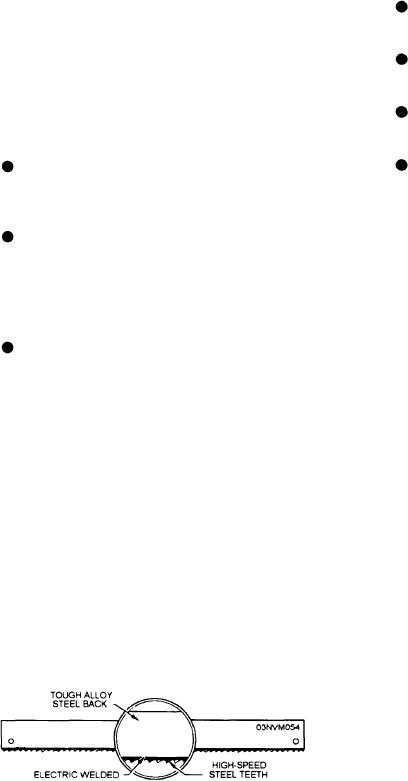
particular job is determined by the size and material
uses are presented later in this chapter to help you
composition of the section and the material to be cut.
understand the differences in blades.
Use coarse pitch teeth for wide, heavy sections to
POWER HACKSAWS
provide ample chip clearance. For thinner sections,
use a blade with a pitch that will keep two or more
The power hacksaw (fig. 5-53) is found in all
teeth in contact with the work so that the teeth will not
except the smallest shops. It is used to cut bar stock,
straddle the work and strip the teeth. In general, you
pipe, tubing, or other metal stock. It consists of a base,
should select blades according to the following
a mechanism for causing the saw frame to reciprocate,
information:
and a clamping vise for holding the stock while it is
being sawed. There are two types of power hacksaws:
Coarse (4 teeth per inch) for soft steel, cast
the direct mechanical drive and the hydraulic drive.
iron, and bronze
The power hacksaw shown in figure 5-53 has a
Regular (6 to 8 teeth per inch) for annealed
capacity of 4" 4". This means it can handle material
high-carbon steel and high-speed steel
up to 4 inches wide and 4 inches high.
Medium (10 teeth per inch) for solid brass
A power hacksaw will have one of three typos of
stock, iron pipe, and heavy tubing
feed mechanisms:
Fine (14 teeth per inch) for thin tubing and
Mechanical feed, which ranges from 0.001 to
sheet metals
0.025 inch per stroke, depending upon the
class and type of material being cut
speeds
Hydraulic feed, which normally exerts a con-
Speed for hacksaws is stated in strokes-per-minute,
stant pressure, but is designed so that the feed
counting only those strokes that cause the blade to make
stops automatically at hard spots to decrease
a cut on the stock are counted. A gear shift lever is used
the pressure on the saw until the hard spot has
to change speeds. There may be a card attached to or
been cut through.
near the saw giving recommended speeds for cutting
various metals. However, you may use the following
Gravity feed, in which weights are placed on
speeds:
the saw frame and shifted to give more or less
pressure of the saw blade against the material
-- Cold-rolled or machine steel, brass, and soft
being cut.
metals--136 strokes per minute.
All three types of feed mechanisms lift the blade
-- Alloy steel, annealed tool steel, and cast iron--
clear of the work during the return stroke.
90 strokes per minute.
-- High-speed steel, unannealed tool steel, and
Hacksaw Blades
stainless steel--60 strokes per minute.
The blade shown in figure 5-54 is especially
designed for use with the power hacksaw. It is made
with a tough alloy steel back and high-speed steel
You should use a coolant for most power hacksaw-
teeth. This combination gives both a strong blade and
ing operations. (Cast iron should be dry when it is cut.)
a cutting edge suitable for high-speed sawing.
The coolant prevents overheating of the blade and stock
These blades vary as to the pitch of the teeth
along with increasing the cutting rate. A soluble oil
(number of teeth per inch). The correct pitch for a
solution with a mixture of the oil and water will be
suitable for most sawing operations. The normal mix-
ture for soluble oil is 40 parts water to 1 part oil. You
also may use a synthetic coolant.
METAL-CUTTING BANDSAW MACHINES
Metal-cutting bandsaw machines are standard
equipment on all repair ships and tenders. These
Figure 5-54.--Power hacksaw blade.
5-31

